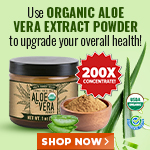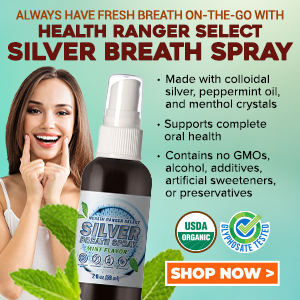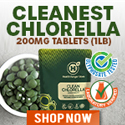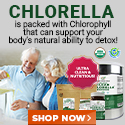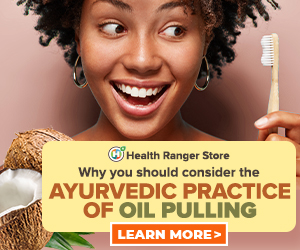
Vitamin D Deficiency Increasingly Linked to Serious Illnesses
Friday, May 15, 2009 by: Ethan Huff
Tags: vitamin D, health news, Natural News
- CLOT SHOT PLANDEMIC UNFOLDING: Fibrous, rubbery clots caused by covid injections have prion-like seeding activity
- Widespread social and economic unrest: Steve Quayle issues urgent financial warning of imminent asset collapse in new interview with Mike Adams
- DEATH by VACCINE or face PRISON time: Canadian Freedom Convoy leaders CONVICTED for protesting forced vaccination during the Covid Plandemic
- How to detox from metals falling out of the sky
- Aerosolized bioweapons? Strange “diploid biomasses” falling out of the sky in Florida captured under the microscope
- How Israeli military-connected corporations are secretly controlling your online privacy
- How the peanut allergy epidemic was fueled by faulty science and institutional arrogance
- Kiss Your Genetic Privacy Good-Bye! 23andMe Gets Green Light to Sell Your Intimate Genetic Details to Anyone They Want
- Analysis: The coming economic collapse, a mass uprising and Trump's three secret weapons to halt the growing revolt
- Thimerosal is 50 percent MERCURY and NO it has NOT been removed from vaccines - that was a BIG FAT LIE the CDC told vax skeptics to keep them vaxxed up and dying
- “Rockefeller Medicine Men”: Today’s healthcare crisis stems from the creation of the American medical establishment
- Mike Adams releases country western hit single: Goin’ Back in Time is Comin’ Home
- EU takes aim at Elon Musk's X with potential $1 billion fine under Digital Services Act
- Global financial Ponzi scheme collapses in real time as markets plummet, Mike Adams and Steve Quayle warn of impending chaos
- European Court of Justice: Healthcare professionals who promoted or administered COVID-19 vaccines are CRIMINALLY LIABLE for any harm caused
- Defunding DEADLY mRNA jabs: Government funding for mRNA technology being scrutinized and sidelined until proven "safe and effective" for real
- New York governor signs controversial gun control measure, sparking Second Amendment concerns
- Washington State expands hate crime bill but ignores left-wing violence against Tesla owners
- Aerosolized bioweapons? Strange “diploid biomasses” falling out of the sky in Florida captured under the microscope
- European Court of Justice: Healthcare professionals who promoted or administered COVID-19 vaccines are CRIMINALLY LIABLE for any harm caused
- Newly released JFK files reveal Pentagon's role in creating Lyme disease and covid in the same lab
- Analysis: The coming economic collapse, a mass uprising and Trump's three secret weapons to halt the growing revolt
- FBI imposed gag order on agents to silence Hunter Biden laptop truth before 2020 election, new chat logs reveal
- Britain’s descent into police state censorship: Parents raided for questioning their daughter’s school system online
- “Project Aldrin”: Senate probes Meta's alleged censorship dealings with China
- Kiss Your Genetic Privacy Good-Bye! 23andMe Gets Green Light to Sell Your Intimate Genetic Details to Anyone They Want
- Oncologist warns of ‘terrifyingly aggressive’ cancers in children, linked to immune suppression from COVID vaccines
- Mike Adams releases country western hit single: Goin’ Back in Time is Comin’ Home
- Utah governor allows ban on LGBT pride flags in public buildings and schools, will take effect without his signature
- AI-powered forecasting model proves more accurate than traditional systems at predicting the weather
- When antibiotics are unavailable, natural ANTIMICROBIAL compounds become essential first line defenses against infection
- German researchers find link between mRNA vaccines and GENETIC CHANGES that precede CANCER and AUTOIMMUNE DISORDERS
- Defunding DEADLY mRNA jabs: Government funding for mRNA technology being scrutinized and sidelined until proven "safe and effective" for real
- The Health Ranger releases “Vaccine Zombie” song and music video, using AI-animated zombies for the music video
- Dr. Mary Talley Bowden drops bombshells about children being permanently damaged by mRNA jabs during Tucker Carlson interview
- The hidden war above: Chemtrails, HAARP and the battle for planetary control
- Newly released JFK files reveal Pentagon's role in creating Lyme disease and covid in the same lab
- California's social media censorship law struck down: A victory for free speech or a threat to online safety?
- The Health Ranger releases “Vaccine Zombie” song and music video, using AI-animated zombies for the music video
- Dr. Mike Yeadon releases 15-minute testimony - WATCH - about genocidal intent of COVID “vaccines”
- EPA advisor admits the agency is funneling billions to climate groups ahead of Trump’s return to White House
- Rep. Nancy Mace introduces bill to ban biological males from female facilities on federal property
- Mike Adams releases country western hit single: Goin’ Back in Time is Comin’ Home
- Florida takes a stand: DeSantis proposes permanent ban on mRNA vaccine mandates
- Sugarcane extract superior to cholesterol-lowering drugs?
- Survival 101: Effective EMF blocking techniques
- OpenAI whistleblower who dissented against how the company trained ChatGPT found dead
- CONSERVATIVES SOUND THE ALARM: Big Pharma and the Left trying to force $32 billion money grab from America’s seniors into year-end spending deal
- Pilots report mysterious lights 'moving at extreme speeds' across Oregon skies
- Attorney and TikTok influencer explains how he was offered hundreds of dollars to make false claims about Trump, Republicans
- Trump reverses course on Gaza plan, says “nobody is expelling Palestinians”
- Trump expected to choose Kelly Loeffler as his agriculture secretary even though she was caught INSIDER TRADING during COVID
- MEDICAL BOMBSHELL: FDA admits Covid mRNA 'Vaccines' CAUSE CANCER
- Marketing director responsible for WOKE Jaguar rebrand is also an LGBT activist who supports Black Lives Matter
- Red Cross issues warning to stop blood plasma donations from vaccinated people
- Scientists confirm: GENIUS brain function can be spontaneously unleashed in humans without any apparent cause
- EPA advisor admits the agency is funneling billions to climate groups ahead of Trump’s return to White House
- HYSSOP: What research reveals about the health benefits of this ancient holy herb
- Two containers with completed ballots fall out of truck in Florida
- Fully vaccinated about to see “tsunami” of illness and death, warns virologist
- Global leaders unite to clamp down on “misinformation” with UN-backed Cascais Declaration
- Newly released JFK files reveal Pentagon's role in creating Lyme disease and covid in the same lab
- BREAKING: 2025 NDAA authorizes mandatory military draft of WOMEN across America… as Pentagon pursues global NUCLEAR war with both Russia and China at the same time
- Michael Yon warns of a ZIONIST TAKEOVER in Trump’s second administration
- Ozempic and Wegovy weight loss drugs are injectable LIZARD VENOM PEPTIDES that may unleash a devastating wave of organ failure… side effects align with symptoms of SNAKE BITES
- BOMBSHELL: DNA testing kits are a SCAM to develop ethnic-specific bioweapons
- The Health Ranger releases “Vaccine Zombie” song and music video, using AI-animated zombies for the music video
- Israeli soldiers accused of even more torture and abuse in the West Bank
- These 13 countries just signed an agreement to engineer a global FAMINE by destroying food supply
- NASA admits that climate change occurs because of changes in Earth’s solar orbit, and NOT because of SUVs and fossil fuels
- RFK Jr. clears key hurdle: Sen. Susan Collins backs controversial HHS nominee, signaling a new era for health policy
- Sermon 30: How Jesus reveals Caesar’s FAKE CURRENCY and FALSE AUTHORITY
A necessary component in perpetuating wellness, vitamin D facilitates proper blood sugar and calcium levels in the body as well as maintains proper heart function and gastrointestinal health. It is also said to protect the body from various infections, osteoporosis, diabetes, and even cancers. Since vitamin D is naturally present in very few foods, it is best obtained through skin exposure to sunlight whose UVB rays cause the body to produce the vitamin naturally and to the proper levels.
According to the Office of Dietary Supplements, the recommended daily intake, or adequate intake (AI), of vitamin D in healthy adults under 50 is a mere 200 international units (IU) while the U.S. Institute of Medicine recommends between 200 IU and 400 IU. While these levels may be adequate in preventing rickets, they have been found to be far too low in preventing the major diseases previously mentioned.
Many naturopathic physicians recognize that anywhere between 4,000 IU and 10,000 IU of vitamin D a day is a more appropriate therapeutic range, considering upper levels of vitamin D are generally recognized to be about 40,000 IU per day, a level far greater than the recommended daily intake thresholds established by mainstream medicine. Contrary to popular misperception, vitamin D is not dangerous nor is it toxic. With a therapeutic index of 10 (40,000/4,000), vitamin D is considered by the Vitamin D Council to be twice as safe as water in terms of "overdosing". In other words, vitamin D is safe and beneficial in relatively large amounts.
While sun exposure is the best method of achieving optimal vitamin D levels, it is difficult during the winter months to get enough exposure to the sun to generate adequate amounts of it. Due to the increasingly acute angle of the sun during the winter months, UVB rays have a harder time penetrating the atmosphere and reaching the skin. Since this time of year is also much colder, people spend little time outside. These factors have led many to conclude that this combination of minimal sun exposure and scarce UVB rays, resulting in severe vitamin D deficiency, facilitates events like the "flu season" and other seasonal sickness patterns that seem to occur when human beings are exposed to the least amount of sunlight.
Because of the undeniable connection between vitamin D deficiency and serious illness, many doctors are now recommending vitamin D supplementation. However, there are two major forms of vitamin D â€" ergocalciferol (D2) and cholecalciferol (D3). Which one is the best to use?
According to a 2004 study in the Journal of Clinical Endocrinology & Metabolism, cholecalciferol (D3), the animal-derived form of vitamin D that perfectly matches the human form in terms of conversion to 1,25-dihydroxyvitamin D, is more than three times more potent than ergocalciferol (D2), a plant form that does not properly metabolize to confer the many benefits of vitamin D. This study is one of many that illustrates the superiority of vitamin D3 over vitamin D2 in both potency and effectiveness.
As previously mentioned, sun exposure is by far the preeminent method of obtaining vitamin D and one should utilize sun exposure as much as possible to maintain optimal health. Because the human body has a built-in mechanism for regulating vitamin D conversion, it is impossible to get too much vitamin D from the sun. Once the body creates the perfect amount, it shuts off for the day and begins its important protective and healing work. But in the winter when sunlight is scarce and exposure is limited, vitamin D3 supplementation is a person's best bet for staying healthy.
Sources:
Forbes.com - Critically Ill Patients Lack Vitamin D
Office of Dietary Supplements
Vitamin D Council
Journal of Clinical Endocrinology & Metabolism
About the author
Ethan Huff is a freelance writer and health enthusiast who loves exploring the vast world of natural foods and health, digging deep to get to the truth. He runs an online health publication of his own at http://wholesomeherald.blogspot.com.Vitamin D at FETCH.news
Get independent news alerts on natural cures, food lab tests, cannabis medicine, science, robotics, drones, privacy and more.
Take Action: Support Natural News by linking to this article from your website
Permalink to this article:
Embed article link: (copy HTML code below):
Reprinting this article:
Non-commercial use OK, cite NaturalNews.com with clickable link.
Follow Natural News on Facebook, Twitter, Google Plus, and Pinterest
Science News & Studies
Medicine News and Information
Food News & Studies
Health News & Studies
Herbs News & Information
Pollution News & Studies
Cancer News & Studies
Climate News & Studies
Survival News & Information
Gear News & Information
News covering technology, stocks, hackers, and more



"Big Tech and mainstream media are constantly trying to silence the independent voices that dare to bring you the truth about toxic food ingredients, dangerous medications and the failed, fraudulent science of the profit-driven medical establishment.
Email is one of the best ways to make sure you stay informed, without the censorship of the tech giants (Google, Apple, Facebook, Twitter, YouTube, etc.). Stay informed and you'll even likely learn information that may help save your own life."
–The Health Ranger, Mike Adams













